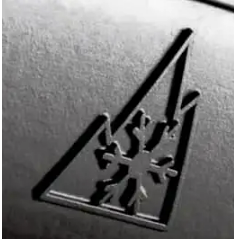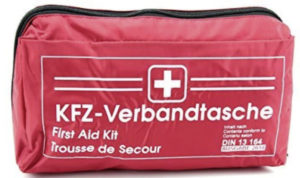The winter conditions in Germany can make the roads dangerous and slippery to drive on.
Winter conditions are for example black ice, slippery snow, slush, slippery ice or frost. (Glatteis, Schneeglätte, Schneematsch, Eis- und Reifglätte).
According to German law (November 2010), you are not allowed to drive without Winter tyres on your vehicle in winter conditions. This makes it a situational requirement (Situative Winterreifenpflicht). – Section 2, Paragraph 3a of the Road Traffic Regulations / § 2 Absatz 3a StVO
When to change to winter tyres
It is hard to say when there will be winter road conditions so most follow the old rule of thumb from October until Östern (O bis O Regel)
How do I identify a winter tyre?
As of January 2018, all new winter tyres can be identified by the Alpine symbol, a mountain pictogram with a snowflake.
In addition, tires with M + S, which stands for mud and snow marking are considered suitable for winter until September 30, 2024, if they have been manufactured by December 31, 2017.
When buying new tyres, make sure they carry the Alpine symbol.

Exceptions
Motorcycles are excluded from this rule, as well as commercial vehicles for agriculture and forestry.
Rental cars are not excluded, always make sure the car has the correct tyres fitted.
If you have a flat tyre, you may replace it with a summer tyre but it must be changed to a winter tyre as soon as possible
Recommendations
Replace tyres after six years at the latest because the rubber will lose its grip in low temperatures after a while.
On the tyres, a minimum residual profile of 1.6 mm is required although 4mm is recommended
All season tyres
If an all-season tyre has the Alpine symbol on it, it can be used in winter and summer. If they don’t they are not allowed to be used in winter. According to many people, it seems that all-season tyres are not optimal for mountainous or hilly areas, see the tips section below.
Fines
Anyone who does not use the prescribed tires in winter conditions can be fined at least 60 euros and one point in Flensburg.
Flensburg is a central register of all traffic violations in Germany. Driving offences are assigned a certain number of points.
If you have more than 4 points against your name, various penalties come into effect.
If you have 8 points, you will lose your licence to drive a vehicle
Insurance
Please refer to your insurance contracts, although driving without winter tyres in Winter conditions, will most likely impact you negatively.
More information
From Busgeldkatalog:
“Die Winterreifenpflicht in der StVO (Straßenverkehrsordnung)
Seit 2010 hält die StVO präzisere Informationen zur Winterreifenpflicht in Deutschland bereit. Das Gesetz schreibt vor: Winterreifen, oder auch Reifen die der Richtlinie 92/23/EWG entsprechen, müssen genutzt werden, wenn „Glatteis, Schneeglätte, Schneematsch, Eis- oder Reifglätte“ vorherrscht (§ 2 Absatz 3a StVO). Dabei war es bis Ende 2017 noch ausreichend, dass Winterreifen mit M+S gekennzeichnet waren.
Seit Januar 2018 gilt: Die Winterreifenpflicht erfüllen neue Winterreifen nur noch, wenn diese das sogenannte Alpine-Symbol aufweisen können. Dieses zeigt sich als dreigezacktes Bergpiktogram mit einer Schneeflocke in der Mitte. Das zuvor ausreichende M+S-Zeichen erfüllt bei neu zum Verkauf stehenden Reifen nicht mehr die gesetzlichen Anforderungen. Es gibt jedoch eine Übergangsregelung bis zum 30. September 2024. Vor 2018 gekaufte Winterreifen mit M+S-Kennzeichnung erfüllen ebenfalls die Winterreifenpflicht, bis zu diesem Tag. Das soll die Verbraucher entlasten, die so nicht sofort Geld in neue Winterreifen stecken müssen.
Mit Bezug auf die Winterreifenpflicht gab es zum Thema Mindestprofiltiefe lange Zeit viele Diskussionen. Fordert der Gesetzgeber auch bei Winterreifen eine Reifenprofiltiefe von 1,6 Millimetern, so geben sich Automobilclubs wie der ADAC erst ab einer Tiefe von vier Millimetern zufrieden. Das Hauptargument dabei: Unter dieser Profiltiefe lassen die Wintereigenschaften der Bereifung stark nach. Der Gesetzgeber hat sich aber gegen eine Verschärfung der Gesetze entschieden, auch da die meisten Verkehrsteilnehmer selbst verantwortungsvoll mit abnehmender Profiltiefe umgehen.”
Tips form our FB members
Related content

Car Insurance
You cannot register your vehicle without having insurance. There are basically three options for vehicle insurance – third-party, partial or comprehensive.Third-party liability insurance is compulsory,

First aid kit
The traffic law in Germany stipulates that all drivers must carry a first aid kit (Verbandkasten) in their vehicle. The contents of your first aid

Road Rules
Driving on German roads is very well regulated and if you don’t adhere to the rules you will get penalty points against your name

Driving and Driver’s licences
If you are only visiting, you need an International driver permit which you can apply for at the AA in South Africa If you stay



You must be logged in to post a comment.